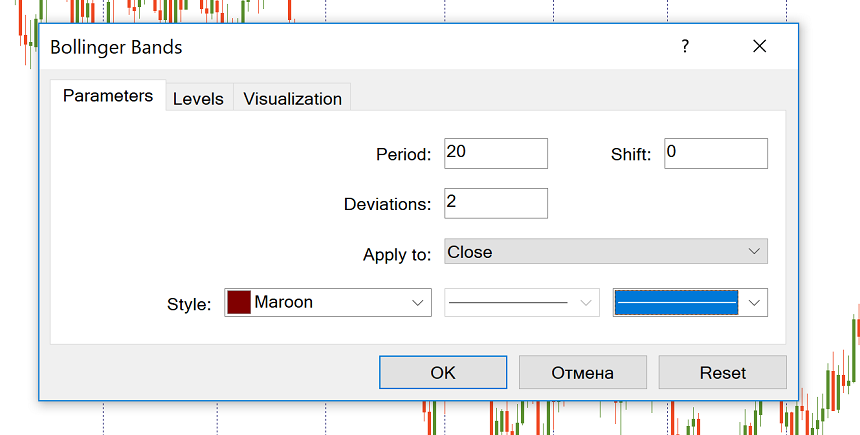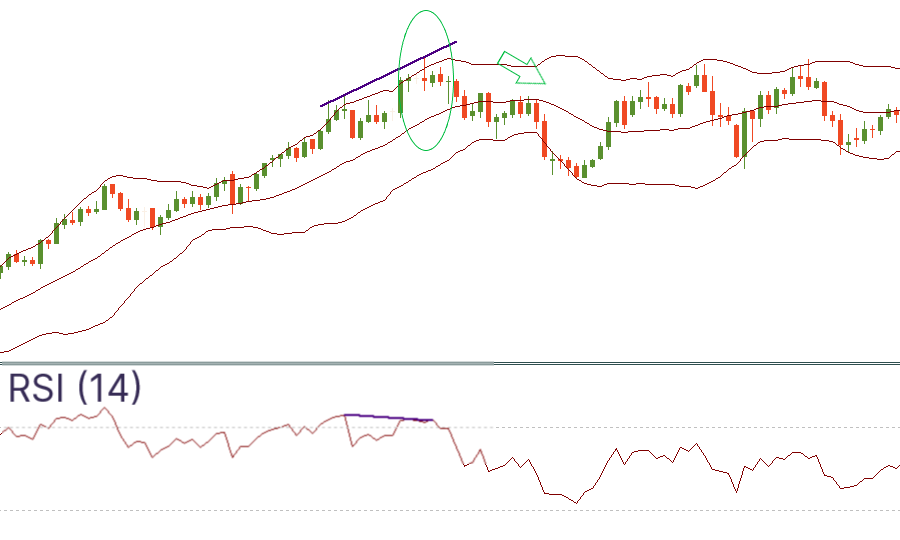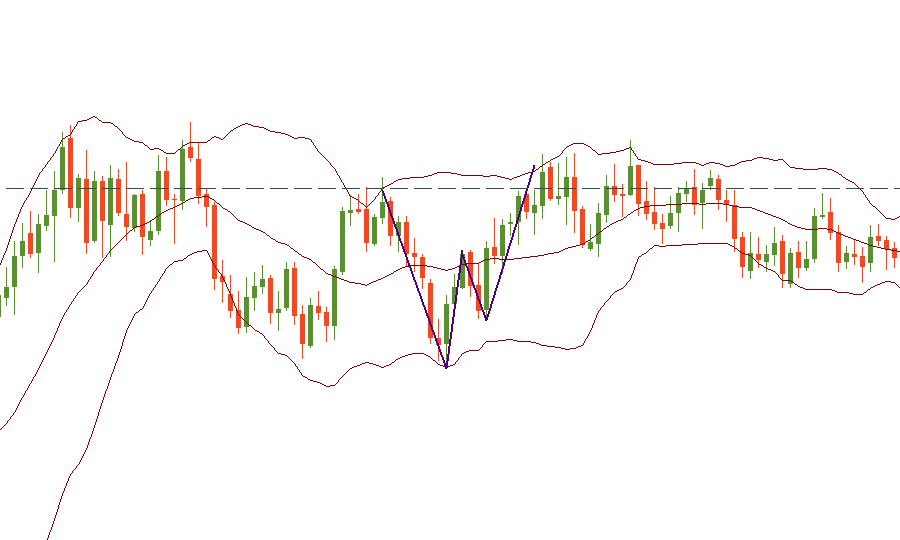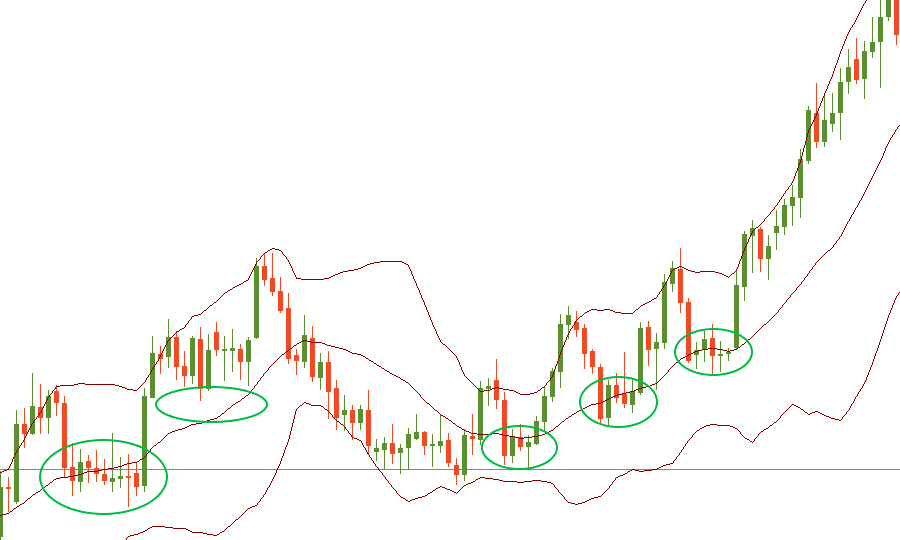Bollinger bands
Information is not investment advice
The Bollinger bands (BB) is a classic trend indicator developed by John Bollinger. His book Bollinger on Bollinger Bands contains a detailed description of how to use it on its own as well as with other tools of technical analysis. BB is very popular among traders all over the world. It is a type of statistical chart characterizing the prices and volatility over time of a financial instrument or commodity, using a formulaic method.
About Bollinger bands
The indicator consists of 3 lines – a middle band and two outer ones. The middle band is a simple moving average, usually with the period of 20. The outer bands are usually set 2 standard deviations above and below the middle band.
The Bollinger bands have something in common with the Envelopes indicator. The difference is that the borders of Envelopes are situated above and below the moving average at the fixed distance in %, while the borders of the Bollinger bands are calculated on the basis of the constantly changing standard deviation.
How to implement
The Bollinger Bands belongs to the default set of MetaTrader. You can add it to the chart by clicking “Insert” – “Indicators” – “Trend” and then choosing “Bollinger bands”.

MT will offer you 20 as period and 2 for deviation. You can change these parameters if you want to. It’s recommended to use periods from 13 to 24, while the deviation should be in the range between 2 and 5. For example, it’s possible to use 50 and 2.1 for longer timeframes and 10 and 1.9 shorter timeframes. Notice that the smaller the period, the more trading opportunities will be offered by the indicator. The number of false signals, however, will be greater as well. At the same time, when the period is big, the indicator becomes less sensitive. This is not suitable for the markets with low volatility.
To make a conclusion, it would be wise to adjust the Bollinger bands for the asset you trade. If the price crosses the upper or the lower band too often, it’s necessary to increase the period. If the price rarely reaches the outer bands, there’s a sense to reduce the period.
The BB can be used on all timeframes, although the indicator is more common for the intraday one. You can also apply the Bollinger bands to an oscillator that is drawn in a separate window below the price chart. For example, you can apply BB onto an RSI by selecting "Previous Indicator's Data" or "First Indicator's Data" in the Bollinger bands' "Apply to" drop-down menu.
How to use Bollinger bands to trade Forex
- The assumption is that the price spends 95% of the time between the outer Bollinger bands and only 5% of the time outside of them.
- Bollinger bands help to determine how big is the deviation from the average price of a currency pair.
- The middle line may be used as a level of support/resistance, while the outer borders can act as profit targets. There are also strategies that imply trading reversals from the outer bands.
- The slope of BB and the position of the price relative to the middle band allow judging the direction of the current trend. If Bollinger bands have an upward bias and the price tends to be above the middle line, it’s an uptrend.
- If the band’s bias is negative and the price spends the majority of time below the middle line, it’s a downtrend.
Bollinger Bands as an indicator of volatility
The key feature of the BB is that the indicator's lines react to the market’s volatility: bands widen when the volatility is high (for example, when an important news release is out) and narrow when it declines.
As a result, the Bollinger Bands help to notice the moment when the market switches from the calm to the active state. When the bands come closer to each other they tell us that we are trading in the non-volatile market and that a volatile period is looming on the horizon. As a result, it’s possible to expect a breakout of the recent range.
You can see the example of this at the picture below: the bands compress and then the price breaks above the resistance and make big moves to the upside.

During a trending market, if the bands widen, this points at the continuation of a trend. If they become narrow, this may signal that the trend is weakening and may soon reverse.
Trading a move beyond the outer borders
Usually, when the price goes beyond the outer Bollinger band, it signals the start or continuation of a trend. If the prices touch and break the upper BB, it’s an uptrend. If the price keeps attacking the lower BB, it’s a downtrend.

Most often the price spends no more than 4 candlesticks beyond an outer Bollinger band. Then a correction takes place. Notice that when the market is trending the price can spend a great deal of time in the area/at one of the outer bands.
Trading a reversal from the outer bands
The Bollinger bands can also act as an oscillator. When the price reaches the upper band, the asset is trading at a relatively high price and is considered overbought. When a price approaches the lower band, the asset is trading at a relatively low price and is considered oversold. It’s common knowledge that overbought and oversold conditions lead to a correction.
However, if the trend is strong, the price can stay at the upper/lower Bollinger band or even beyond it without retracement for a prolonged period of time as we have learned from the previous passage. As a result, if you want to trade on the pullback from the upper or lower Bollinger band, you will need a confirmation of the market’s reversal from candlestick patterns or another indicator.

The picture above shows that the reversal down from the upper BB is confirmed by the bearish candlestick pattern (evening star) and the bearish divergence between RSI and the price chart.
There are examples of a particular sort of price action near the outer Bollinger bands. A W-bottom forms in a downtrend and involves two reaction lows. The second low should be lower than the first one and hold above the lower band. M-top is the opposite of a W-bottom. In its most basic form, it is similar to a double top. However, the reaction highs are not always equal. The first high can be higher or lower than the second one. The use of Bollinger Bands for 'M' and 'W' signals looks to provide earlier indications than those produced by the conventional 'M' and 'W' chart patterns.

Trading a crossing of and a pullback from the middle line
The middle line acts as a dynamic support/resistance. If the price crosses the middle BB, it signals the change in trend. Don’t forget to look for confirmations in such cases.
Notice that the price often tests levels beyond the middle line before reversing, and these false breakouts that may confuse traders.
If the price deflects off the lower band and crosses the middle line to the upside, the upper band will be the upper price target. In a strong uptrend, prices usually fluctuate between the upper band and the middle band. As a result, in a strong uptrend, consider looking for buying opportunities at the middle band. If the uptrend is not so strong, corrections may be deeper and reach the lower BB. In a strong downtrend, look for selling opportunities at the middle BB. If the downtrend is not so strong, retracements may take the price up to the upper BB.

Conclusion
The Bollinger bands indicator is a very useful technical tool that can form a solid basis for a very good trading system. It provides dynamic support and resistance levels and visualizes the level of volatility. Take your time to master this tool!
Other articles in this section
- Timeframes
- Renko charts Japanese candlestick chart
- Types of charts
- Heiken Ashi
- Quantitative easing policy
- Pivot Points
- ZigZag
- Moving Average
- Williams’ Percent Range (%R)
- Relative Vigor Index (RVI indicator)
- Momentum
- Force index
- Envelopes
- Bulls Power and Bears Power
- Average True Range
- How to trade on central bank decisions?
- CCI (Commodity Channel Index)
- Parabolic SAR
- Stochastic Oscillator
- Relative Strength Index
- Oscillators
- ADX indicator
- Trend indicators
- Introduction to technical indicators
- Support and resistance
- Trend
- Technical analysis
- Central Banks: policy and effects
- Fundamental factors
- Fundamental analysis
- Fundamental vs technical analysis











